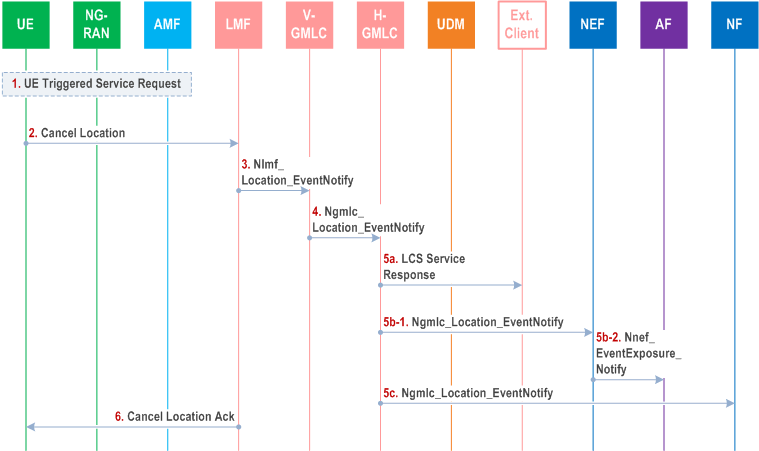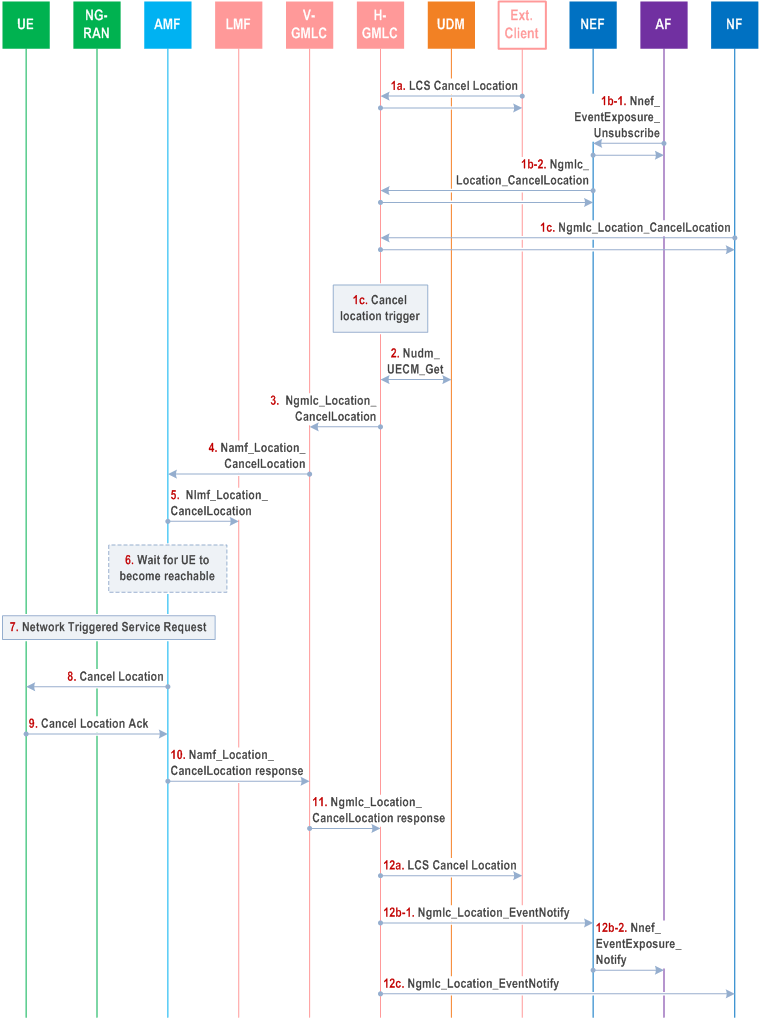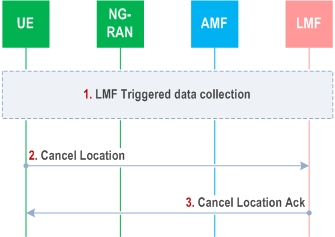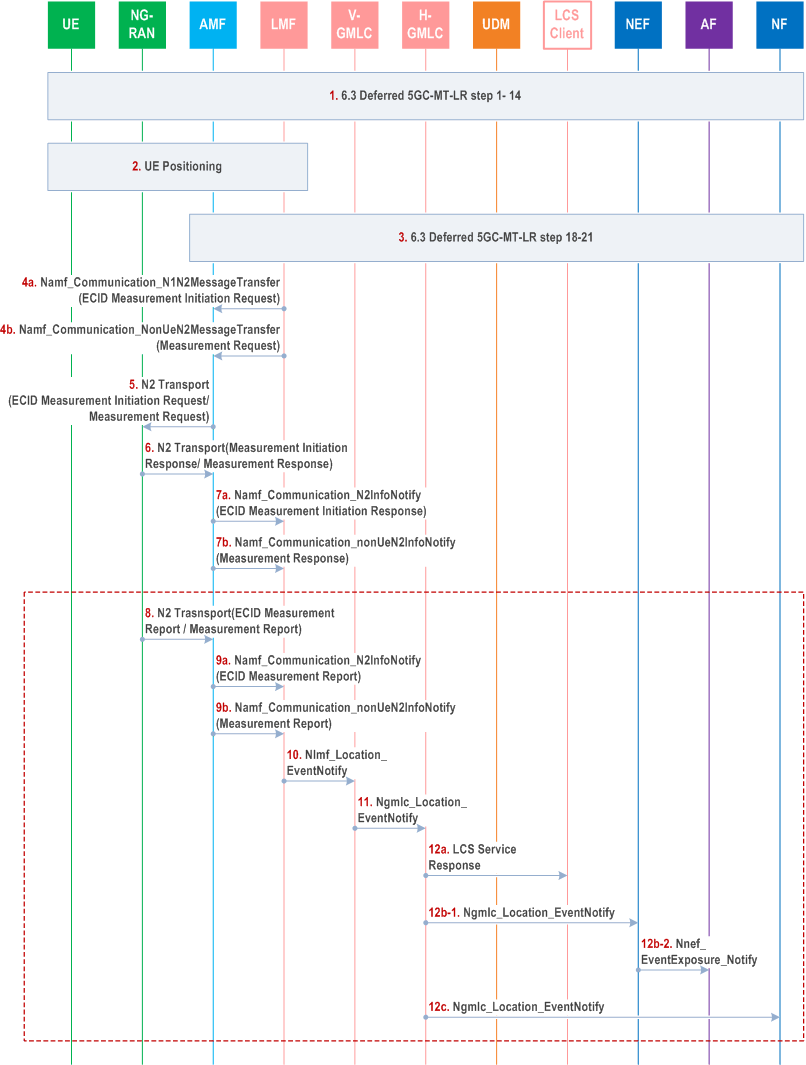Content for TS 23.273 Word version: 19.1.0
1…
4…
4.2…
4.2a…
4.3…
5…
5.5…
6…
6.1.2
6.1.3
6.1.4…
6.2
6.3…
6.3.2…
6.4
6.5…
6.7…
6.7.3
6.7.4
6.7.5
6.8
6.9…
6.10…
6.11…
6.12…
6.13…
6.14…
6.15…
6.16…
6.17…
6.18…
6.19…
6.19.2…
6.20…
6.20.4…
6.21…
7…
8…
A…
B…
C…
6.3.2 Cancellation of Reporting of Location Events by a UE
6.3.3 Cancellation of Reporting of Location Events by an AF, an NF or External LCS Client or GMLC
6.3.4 Cancellation of Reporting of data collection by a UE
6.3.5 Deferred 5GC-MT-LR Procedure for Periodic Location Events based on NRPPa Periodic Measurement
6.3.5.1 Initiation and Reporting of Periodic Events based on NRPPa Periodic Measurement
6.3.5.2 Cancellation of Reporting of Periodic Events by an AF, an NF or External LCS Client or GMLC
...
...
6.3.2 Cancellation of Reporting of Location Events by a UE p. 73
Figure 6.3.2-1 summarizes a procedure to enable a UE to cancel a deferred 5GC-MT-LR procedure for periodic, or triggered location events (e.g. if the UE is powered off or if the UE cancels the location request based on user's input). It is assumed that a deferred 5GC-MT-LR for periodic or triggered location events has already been initiated in the UE according to steps 1-17 for the procedure in clause 6.3.1. If a network entity (e.g. (H)GMLC, AMF or LMF) cancels a deferred 5GC-MT-LR procedure for periodic or triggered location events, part of the procedure in clause 6.3.3 for cancellation by an AF, an NF or external LCS Client would be used to cancel towards the UE and part of the procedure in this clause would be used to cancel towards the AF, the NF or external LCS Client.

Step 1.
The UE performs a UE triggered service request as defined in clause 4.2.3.2 of TS 23.502 if in CM-IDLE state in order to establish a signalling connection with the AMF.
Step 2.
The UE sends a Cancel Location request message to the LMF which is transferred via the serving AMF and is delivered to the LMF using an Namf_Communication_N1MessageNotify service operation. The UE includes the deferred routing identifier originally received in step 16 of the procedure in clause 6.3.1 (or as updated by step 26 in clause 6.3.1 or by the procedure in clause 6.4) in the NAS Transport message used to transfer the cancel location request from the UE to the AMF. The AMF then forwards the cancel location request to either the serving LMF or any suitable LMF based on whether the deferred routing identifier indicates a particular LMF or any (default) LMF. The UE also includes the (H)GMLC contact address and the LDR reference number.
Step 3.
In the case of roaming, the LMF selects a VGMLC. The LMF then invokes an Nlmf_Location_EventNotify service operation towards the selected VGMLC or (H)GMLC with an indication of the cancelation of location event reporting, the (H)GMLC contact address and LDR reference number.
Step 4.
This step is skipped for a non-roaming UE. For a roaming UE, the VGMLC invokes an Ngmlc_Location_EventNotify service operation to forward the cancel location request (including the LDR reference number) to the HGMLC which identifies the periodic and triggered location request from the LDR reference number.
Step 5.
The (H)GMLC uses the LDR reference number received in step 3 or step 4 to identify the periodic and triggered location request received in step 1 of clause 6.3.1 and then forwards the cancel location to the external LCS client, the NF or the AF (via the NEF).
Step 6.
The LMF returns an acknowledgment to the UE via the serving AMF.
6.3.3 Cancellation of Reporting of Location Events by an AF, an NF or External LCS Client or GMLC p. 74
Figure 6.3.3-1 summarizes a procedure to enable an AF, an NF or External LCS Client or GMLC to cancel a deferred 5GC-MT-LR procedure for periodic, or triggered location. It is assumed that a deferred 5GC-MT-LR for periodic or triggered location events has already been requested according to the procedure in clause 6.3.1 up until at least step 20.

Step 1.
The external LCS client, the NF or the AF (via an NEF) send a request to cancel the periodic or triggered location to the (H)GMLC, the external LCS client, the NF or the AF shall include the identity of the deferred request.
The HGMLC may itself initiate the cancellation procedure, e.g. when it is notified that the UE LCS privacy profile stored in the UDM was changed. For every outstanding Deferred Location Request against that UE, the HGMLC shall perform a new privacy check based on the updated UE LCS privacy profile stored in the UDM. If the privacy check passes, i.e. the LCS Client is still allowed to position the target UE, the handling of the outstanding Deferred Location Request shall be continued. Otherwise, if the privacy check does not pass, i.e. the Location estimate of the target UE is not allowed to be provided to the LCS Client, the HGMLC shall initiate a cancellation procedure
Step 2.
The (H)GMLC queries the UDM to determine the serving AMF address as in step 3 of clause 6.3.1.
Step 3.
For a roaming UE, the HGMLC obtains a VGMLC address if not received at step 2 and invokes an Ngmlc_Location_CancelLocation service operation to forward the cancellation request to the VGMLC. The (H)GMLC also includes the contact address for the (H)GMLC and the LDR reference number in the request and the latest LMF identification received in step 20 or step 29 in clause 6.3.1 if either step has occurred and included an LMF identification.
Step 4.
The (H)GMLC or VGMLC invokes the Namf_Location_CancelLocation service operation to forward the cancellation request to the serving AMF and includes the (H)GMLC contact address, LDR reference number and LMF identification if available.
Step 5.
If an LMF identification was included in step 4, the AMF forwards the cancelation request to the indicated LMF by invoking an Nlmf_Location_CancelLocation service operation and includes the (H)GMLC contact address and LDR reference number. The LMF then releases all resources for the location request.
Step 6.
If the UE is not currently reachable (e.g. is using eDRX or PSM), the AMF waits for the UE to become reachable.
Step 7.
Once the UE is reachable, if the UE is then in CM IDLE state, the AMF initiates a network triggered Service Request procedure as defined in clause 4.2.3.3 of TS 23.502 to establish a signalling connection with the UE.
Step 8.
The AMF sends the cancelation request to the target UE and includes the (H)GMLC contact address and the LDR reference number. The UE then releases all resources for the location request.
Step 9.
The UE returns an acknowledgment to the AMF.
Step 10.
The AMF responds to Namf_Location_CancelLocation , then V-GMLC or (H)GMLC releases all resources for the location request. AMF releases all resources for the location request.
Step 11.
For a roaming UE, the VGMLC responds to Ngmlc_Location_CancelLocation , then HGMLC releases all resources for the location request.
Step 12.
[Conditional] If the cancellation procedure is requested by HGMLC (i.e. the procedure is triggered in step 1c) and the cancelled location event is reported to external client, the NF or the AF (via NEF).
6.3.4 Cancellation of Reporting of data collection by a UE |R19| p. 75
The procedure described in Figure 6.3.4-1 enables a UE to cancel a data collection by LMF to train the LMF-based AI/ML Positioning model as described in clause 6.22.2, for example if the UE is powered off or if the UE cancels the data collection based on user's input (e.g. UE is not willing to report input data).

Step 1.
The LMF performs a data collection procedure as defined in clause 6.22.2.
Step 2.
Same as step 2 in clause 6.3.2.
Step 3.
same as step 6 in clause 6.3.2.
6.3.5 Deferred 5GC-MT-LR Procedure for Periodic Location Events based on NRPPa Periodic Measurement |R19| p. 76
6.3.5.1 Initiation and Reporting of Periodic Events based on NRPPa Periodic Measurement p. 76

Step 1.
Steps between 8 and 12c are executed periodically.
LMF before step 4 invokes Namf_
Deferred 5GC-MT-LR steps 1-14 are executed as described in clause 6.3.1. AF, LCS clients or NF triggers periodic location event.
Step 2.
LMF performs one or more of the positioning procedures as it is described in step 15 in clause 6.3.1. LMF based on UE capability information received in this step and based on configuration decides to perform NRPPa Periodic Measurements. Once LMF determines to use NRPPa periodic measurement, it may perform Positioning Information Exchange based on an NRPPa protocol in TS 38.455 between the LMF and NG-RAN (e.g. as described in clause 8.2.6.2 of TS 38.455)
Step 3.
Deferred 5GC-MT-LR steps 18-21 are executed as described in clause 6.3.1 with the following changes:
Step 4a-b.
- The NRPPa periodic indication is added to steps 18-20 to indicate Periodic Location Estimates are generated based on NRPPa Periodic Measurement. (H)GMLC stores NRPPa periodic indication.
LMF performs NRPPa Periodic E-CID Measurement Initiation Request (clause 8.2.1.2 of TS 38.455) or LMF performs NRPPa Periodic Measurement Request (clause 8.5.1.2 of TS 38.455). LMF uses the time interval between successive location reports and the total number of reports received in step 1 to setup NRPPa periodical report procedure.
Step 5.
The AMF forwards the message to NG-RAN.
Step 6-7a.
NG-RAN returns with E-CID Measurement Initiation Response (clause 8.2.1.2 of TS 38.455).
Step 6-7b.
NG-RAN returns with Measurement Response (clause 8.5.1.2 of TS 38.455).
Step 8-9a.
LMF is receiving E-CID Measurement Report from NG-RAN periodically (clause 8.2.3.2 of TS 38.455). LMF uses Measurement Information to calculate Location Result.
Step 8-9b.
LMF is receiving Measurement Report from NG-RAN periodically (clause 8.5.2.2 of TS 38.455). LMF uses Measurement Information to calculate Location Result.
Step 10.
LMF invokes Nlmf_Location_EventNotify service operation as described in step 28 in clause 6.3.1 in order to transfer location information to VGMLC or (H)GMLC.
Step 11.
Deferred 5GC-MT-LR step 29 is executed as described in clause 6.3.1.
Step 12a.
Deferred 5GC-MT-LR step 30a is executed as described in clause 6.3.1.
Step 12b-1.
Deferred 5GC-MT-LR step 30b-1 is executed as described in clause 6.3.1.
Step 12b-2.
Deferred 5GC-MT-LR step 30b-2 is executed as described in clause 6.3.1.
Step 12c.
Deferred 5GC-MT-LR step 30c is executed as described in clause 6.3.1.
6.3.5.2 Cancellation of Reporting of Periodic Events by an AF, an NF or External LCS Client or GMLC p. 77
Cancellation of Reporting of Periodic Events by an AF, an NF or External LCS Client or GMLC based on NRPPa Periodic Measurement executed as described in clause 6.3.3 with the following changes:
- Steps from 6 to 9 are not executed based on NRPPa periodic indication provided by VGMLC in step 4. (i.e. UE's related procedures are not executed).
-
When in step 5 LMF receives Namf_
Location_ , LMF stops NRRPa periodic measurement report by requesting E-CID Measurement Termination (clause 8.2.4.2 of TS 38.455) or Measurement Abort (clause 8.5.4.2 of TS 38.455) and unsubscribe for AMF event.CancelLocation